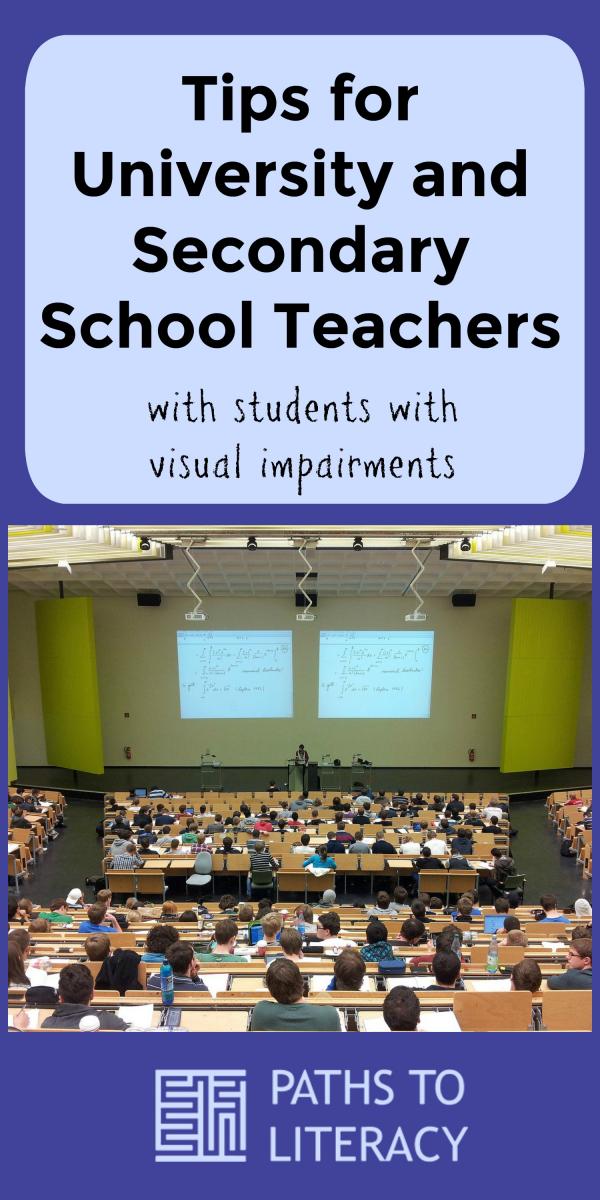Tips for University and Secondary School Teachers

We often get questions from instructors in colleges and universities who, for the first time, will have a student who is blind or visually impaired or blind in one of their classes. After a moment of panic, they contact us for tips and suggestions. As we prepare to start a new school year, we thought it would be helpful to share some general guidelines.
Modifications and Accommodations for Students with Visual Impairments in Higher Education
- Every student is different!
First, it's important to remember that there is not just one single response to the question of how to teach college students who are blind. Begin by meeting directly with the student to find out what her needs are, as different types of visual impairments require different types of accommodations. She may well already have assistive technology devices in place that help her to get her work done. There are some questions that you may wish to ask her when you meet, such as what her preferred learning medium is. Some people with visual impairments are braille readers, others use large print, others use regular print and others depend on auditory methods. Finding out the answer to that will help to guide what type of accommodations are necessary.
- Find out what resources are available on your campus.
Familiarize yourself with the services provided by the University Disability office. Part of their job is to provide support to you as the instructor and to the student with the visual impairment. Every university in the United States has this type of service and they can help you find textbooks in the appropriate format, provide support to the student if she needs a reader or some type of assistive technology, etc. Some colleges and universities also have an Accessible Education Office, whose job is to provide support to you. Check directly with them about what services they offer.
General Guidelines
- Needs will vary, depending on the individual, the curriculum, and the classroom environment.
Accommodations should be based on current individual needs, the content and format of the curriculum, and the classroom environment: this is self-evident in some ways. As mentioned above, the type and severity of the visual impairment will help to determine what type of accommodations are necessary. If you lecture, what type of visual presentations do you use? If you use powerpoint presentations, for example, might these be given to the student before the class session, so that she can review first and follow along with the lecture? Do you write on a whiteboard or blackboard or something else? If so, how might that be made accessible to her? There are various ways this can be done. She may have some type of telescope that allows her to read something at a distance, which just means that you need to write legibly. Or, she might not be able to read print at all, in which case someone will need to transcribe notes from the board. This might be a fellow student, who is willing to share the notes or you or someone who is hired to provide the transcription.
- Check to be sure that your class website and course materials are accessible.
If you have any online materials or a class website, are these accessible? Not all PDFs are accessible (generally anything photocopied and scanned is not accessible, for example). Again, your University Accessibility office should be able to assist with this.
- Provide a list of texts and required readings well in advance.
This is necessary to ensure that all materials will be available in the appropriate format. Again, this will depend on her needs and obviously if she is a braille reader, this will require a lot more advance preparation than if she reads regular print with some kind of magnification device.
Instructional Tips
- Be prepared well in advance.
This seems like a funny thing to recommend to an experienced teacher or a university professor, but often teachers create something at the last minute on the fly. Perhaps you read an interesting article over breakfast that morning and you'd like to share it with your class. Just be aware that she will need to have access to everything that your other students do. Again, this may be no extra work for you at all, if she can read regular print with a magnification device or if the article is available online in an accessible format.
- DO use the same references to "seeing" that you normally do.
In other words, use normal speech, like "Everyone look on page 25" or "See what you think is meant here." This is normal speech and people with visual impairments expect to hear this type of reference. In addition, even with a braille reader, we say "look on page 3". Avoid pointing or any visual references that include specific information, e.g. "If you look over there, you'll see what I mean."
- Use people's names more than you otherwise might.
While this may seem awkward at first, it can be a helpful way for students who are blind to get to know classmates and to follow class discussions. For example, call on a student by name, rather than just pointing to someone who has their hand raised. Refer to the last student's name as you move forward, e.g. "As James just pointed out, we can see this is another example of..."
- Some students may require additional time during timed tests or exams.
Find out from the student if this is necessary. By the time they reach high school or post-secondary education, students should be able to clearly request what type of accommodations they need. They are the best resources for finding out what will be most helpful.
- Make yourself available to the student.
Some students may be shy or recluctant to speak up to request special assistance or clarification. It would be helpful to both parties to establish at the beginning of the term what the expectations are and to discuss ways that additional support may be available, if necessary.
Additional Resources
These articles and websites may be helpful sources of additional information.

